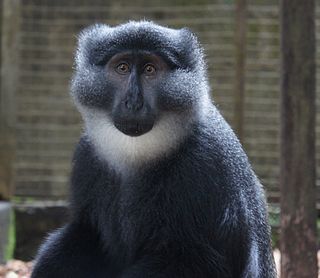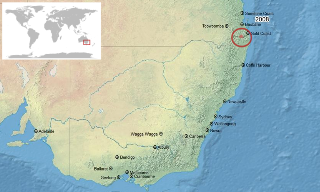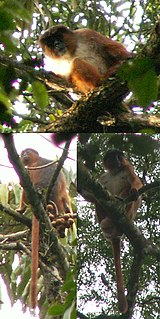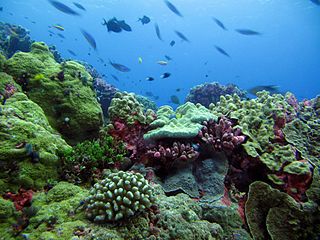
The Preuss's monkey, also known as Preuss's guenon, is a diurnal primate that lives terrestrially in mountainous forests of eastern Nigeria, western Cameroon and Bioko in Equatorial Guinea. It is sometimes classified as a subspecies of the L'Hoest's monkey.
Werneria graminifolia is a species of flowering plant in the Asteraceae family. It is found only in Ecuador. Its natural habitat is subtropical or tropical high-altitude grassland. It is threatened by habitat loss.
Werneria pumila is a species of flowering plant in the family Asteraceae. It is found only in Ecuador. Its natural habitats are subtropical or tropical high-altitude shrubland and subtropical or tropical high-altitude grassland. It is threatened by habitat loss.
Rhinella veraguensis is a species of toad in the family Bufonidae. It is found in the Amazonian versant of the Andes and in the inter-Andean valleys in Bolivia and southeastern Peru. Its natural habitats are montane tropical forests and cloud forests. Breeding takes place in streams. There are no major threats to this common species, although it can locally suffer from habitat loss.
Werneria bambutensis is a species of toad in the family Bufonidae. It is endemic to western Cameroon where it occurs at high altitudes between Mount Manengouba and Mount Oku, including the eponymous Bamboutos Mountains. Its natural habitats are fast-flowing streams at elevations of 1,750–2,600 m (5,740–8,530 ft) above sea level, typically within montane forest patches. Outside the breeding season, it also seems to disperse away from streams into forest patches, open bamboo glades, and montane grassland. It is a rare species that is probably threatened by habitat loss.
Werneria iboundji is a species of toad in the family Bufonidae. It is endemic to Gabon and only known from its type locality, Mont Iboundji. Only two specimens are known, collected from among rocks at the edge of a plunge pool at the base of a large waterfall in lowland forest, at 560 m (1,840 ft) above sea level. It is threatened by logging, which would likely negatively affect the micro-climate—the species depends on high humidity.
Werneria mertensiana is a species of toad in the family Bufonidae. It is found in western Cameroon and possibly in the Obudu Plateau in Nigeria. The specific name mertensiana honours Robert Mertens, a German zoologist and herpetologist. Common name Mertens' smalltongue toad has been coined for it.
Werneria submontana is a species of toad in the family Bufonidae. It is endemic to western Cameroon. It is found primarily at elevations of 800 to 1,200 m above sea level, but sometimes down to 200 m (660 ft), in the Bakossi Mountains, Mwendelengo Mountains, and at the base of Mount Kupe. It has been found in association with rivers. The species can be locally abundant but is threatened by habitat loss. Parts of its range receive protection from the Bakossi Forest Reserve.
Werneria tandyi is a species of toad in the family Bufonidae. It is endemic to western Cameroon and known from Mount Manengouba and from the Rumpi Hills. It lives by fast-flowing streams in submontane forest and degraded secondary habitats, and several individuals may be found clustered together on rocks in the splash zone. It is common within its limited range but threatened by habitat loss caused by agriculture and human settlements. It might occur in the Rumpi Hills Wildlife Reserve.
Nymphargus grandisonae is a species of frog in the family Centrolenidae. It is found in Andes of Colombia and Ecuador. Its natural habitats are tropical moist montane forests ; larvae develop in streams and still-water pools. Its habitat is threatened by habitat loss, introduced fish, and agricultural pollution, but it is still a common species not considered threatened by the IUCN.
Hyalinobatrachium guairarepanense is a species of frog in the family Centrolenidae. It is endemic to Venezuela, where it is found in locations in the Coastal Range at elevations between 720 and 1,000 m above sea level.
Celsiella revocata is a species of frog in the family Centrolenidae. It is endemic to the Venezuelan Coastal Range. Its common name, El Tovar glass frog, refers to its type locality, Colonia Tovar. Its natural habitats are montane forests along streams; it is usually found on vegetation above the streams.
The pine forest stream frog is a species of frog in the family Hylidae found in Guatemala and possibly Mexico. Its natural habitats are subtropical or tropical dry forests, rivers, and heavily degraded former forest. It is threatened by habitat loss.

Kassina maculosa is a species of frog in the family Hyperoliidae. It is found in Cameroon, Central African Republic, and northern Democratic Republic of the Congo, and possibly also in northern Republic of the Congo. Its natural habitats are lowland secondary forests and savanna, and montane forests and grasslands. It tolerates habitat modification and is also found in farm bush. Breeding takes place in standing water, possibly also in streams at high altitudes.
The palm forest tree frog, Leptopelis palmatus, is a species of frog in the family Arthroleptidae endemic to the Príncipe island, in São Tomé and Príncipe. Red tree frog Leptopelis rufus from the African mainland was for a long time included in this species, but is now considered a distinct species.

The Loveridge's frog, also known as the masked mountain frog, is a species of frogs in the family Myobatrachidae.

The Ugandan lowland shrew is a species of mammal in the family Soricidae. It is found in Kenya and Uganda. Its natural habitats are subtropical or tropical swamps and subtropical or tropical moist montane forest. It is threatened by habitat loss.

The Mount Cameroon forest shrew is a species of mammal in the family Soricidae endemic to Cameroon. Its natural habitat is subtropical or tropical moist montane forests.
Neodythemis preussi is a species of dragonfly in the family Libellulidae. It is found in Cameroon, the Democratic Republic of the Congo, Equatorial Guinea, Gabon, Nigeria, Uganda, and Zambia. Its natural habitat is subtropical or tropical moist lowland forests.

Preuss's red colobus is a red colobus primate species endemic to the Cross-Sanaga Rivers ecoregion. An important population occurs in Korup National Park, Southwest Province, Cameroon, but the species' distribution is localized. The species is considered present in adjacent Cross River National Park - Oban Division in Nigeria and hunter reports suggest that few groups remain in Nkwende Hills and Nta Ali Forest Reserve in the broader Korup region. A population is also present in Ebo forest, Littoral Province of Cameroon.










